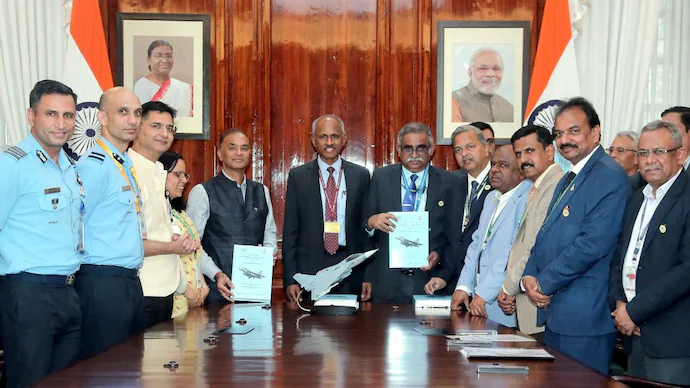In a landmark step for India’s defense modernization and self-reliance drive, the government has finalized a deal worth ₹62,370 crore for the procurement of 97 Tejas Mark-1A fighter jets. The agreement, inked with Hindustan Aeronautics Limited (HAL), represents one of the largest indigenous defense contracts in India’s history and underscores the nation’s commitment to bolstering its air power through homegrown technology.
The Tejas Mark-1A, a fourth-generation plus fighter aircraft, is an advanced version of the Light Combat Aircraft (LCA) Tejas already in service with the Indian Air Force (IAF). Equipped with upgraded avionics, improved radar systems, electronic warfare capabilities, and beyond-visual-range missile integration, the Mark-1A is designed to be both versatile and combat-ready for modern battlefield requirements.
This order of 97 aircraft follows an earlier contract for 83 Tejas Mark-1A jets signed in 2021, taking the total confirmed orders for the platform well past 180 units. With this new deal, HAL’s production lines are set to operate at full capacity, ensuring steady deliveries to the IAF over the next decade. Defense officials have indicated that the delivery schedule will begin in the mid-2020s and continue into the 2030s, ensuring the IAF’s fleet is significantly replenished.
The strategic significance of the deal is multi-dimensional. For the Indian Air Force, which has faced a steady decline in squadron strength over the years due to retiring MiG-21s and delays in foreign acquisitions, the Tejas Mark-1A order provides a much-needed boost. It will enhance operational readiness and help fill critical gaps until more advanced platforms like the Tejas Mark-2 and the AMCA (Advanced Medium Combat Aircraft) enter service.
For India’s defense industry, the contract is a major vote of confidence in indigenous design and production capabilities. The Tejas program has been a long journey, marked by decades of research, setbacks, and perseverance. Today, the Mark-1A variant symbolizes the maturity of India’s aerospace ecosystem, with significant contributions from domestic suppliers in avionics, composites, and systems integration. Officials estimate that nearly 60% of the platform’s components are sourced from Indian companies, a number expected to rise further in future iterations.
Financially, the ₹62,370 crore deal represents a massive injection into India’s defense industrial base, generating employment across HAL’s facilities in Bengaluru, Nashik, and other regions. Ancillary industries—ranging from electronics to composites—are also expected to benefit, creating a ripple effect of jobs and skill development in the wider manufacturing ecosystem.
The government has positioned this procurement as part of its broader Atmanirbhar Bharat initiative, which seeks to reduce reliance on foreign arms imports. By investing heavily in the Tejas platform, India is signaling both confidence in its indigenous capabilities and determination to emerge as a global player in defense production. Export opportunities for Tejas are also being pursued, with several countries expressing interest in the aircraft, a prospect that could be strengthened by the credibility of large-scale adoption by the IAF.
Defense analysts note that while the Tejas Mark-1A may not match the raw power of fifth-generation fighters, it is cost-effective, agile, and well-suited for a wide range of missions, from air defense to ground attack. Its deployment in large numbers will give the IAF tactical flexibility and depth, especially in regional scenarios where quick-response light fighters can be decisive.
In conclusion, the government’s signing of the ₹62,370 crore deal for 97 Tejas Mark-1A jets is more than just a defense acquisition—it is a declaration of India’s confidence in its own technological and industrial strength. As the Tejas takes to the skies in greater numbers, it will not only strengthen national security but also stand as a symbol of India’s progress toward strategic autonomy.



